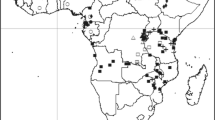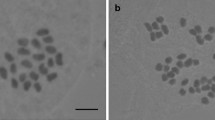Abstract
The taxonomic status ofEupatorium chinese var.oppositofolium andE. glehni (=E. chinense subsp.sachalinense) inE. chinense complex semsu Kitamura has long been controversial. In this paper, the degree of divergence between diploids of these two taxa was examined by means of morphological studies including principal component analysis, the electrophoretic analysis of esterase isozyme variation and observations on habitats. The data obtained through the examinations indicate these two taxa are diverged enough to be recognized as distinct biological species. Since the polyploidE. chinense var.oppositifolium is more or less intermediate in morphology between the two diploid taxa, it is considered to have masked the distinction between the two diploid taxa. Also, electrophoretic evidence suggests that polyploidE. chinense var.oppositifolium is not a hybrid or hybrid derivative withE. glehni as a parental species. Possible origin of polyploidE. chinense varoppositifolium is also discussed.
Similar content being viewed by others
References
Hara, H. 1952. Enumeratio Spermatophytarum Japonicarum 2. Iwanami-shoten, Tokyo.
Kawahara, T., T. Yahara and K. Watanabe. 1989. Distribution of sexual and agamospermous populations in AsianEupatorium (Compositae). Pl. Sp. Biol. (in press).
Kitamura, S. 1937.Eupatorium. Compositae Japonicae 1. Mem. Coll. Sci., Kyoto Imperial Univ. Ser. B13: 283–296.
—. 1949. Taxonomic note on ChineseEupatorium. J. Jap. Bot.24: 76–80 (in Japanese).
—. 1957. Compositae Japonicae pars sexta addition. Mem. Coll. Sci. Kyoto Univ. Ser. B24: 49–50.
—. 1981. Compositae.In Satakeet al., ed., Wild Flowers of Japan III. Herbaceous Plants-sympetalae. Heibonsha, Tokyo (in Japanese).
Lee, T.B. 1979. Illustrated Flora of Korea. Hyangmun-sa, Seoul (in Korean).
Levin, D.A. 1983. Polyploidy and novelty in flowering plants. Amer. Nat.122: 1–25.
Li, H.L. 1978. Flora of Taiwan. Angiospermae IV. Epoch Publ., Taipei.
Ling, Y., Y.L. Chen andC. Shih. 1985. Flora Reipublicae Popularis Sinicaes. Tumus74. Science Press, Beijing (in Chinese).
Mayr, E.. 1942. Systematics and the Origin of Species. Columbia Univ. Press, New York.
Murata, G. andH. Koyama. 1982. OnEupatorium of Japan. Acta Phytotax. Geobot.23: 282–301 (in Japanese).
Ohwi, J. 1953. Flora of Japan. Shibundo, Tokyo (in Japanese).
—. 1965. Flora of Japan (English ed.). Smithsonian Inst., Washington D.C.
Shaw, C.R. andR. Prasad. 1970. Starch gel electrophoresis of enzymes—a compilation of recipes. Biochem. Genet.4: 297–320.
Stebbins, G.L. 1971. Chromosomal Evolution in Higher Plants. Edward Arnold, London.
Watanabe, K. 1986. The Cytogeography of the genusEupatorium (Compositae)—A review. Pl. Sp. Biol.1: 99–116.
—,T. Fukuhara andY. Huziwara. 1982. Studies on the Asian eupatorias I.Eupatorium chinense var.simplicifolium from the Roko Mountains. Bot. Mag. Tokyo95: 261–280.
— andT. Yahara. 1984. Studies on the Asian eupatoria II. Cytogeography ofEupatorium chinense subsp.Sachalinense var.oppositifolium. Bot. Mag. Tokyo97: 87–105.
Yahara, T. andV.I. Sullivan. 1986. Peroxydase phenotypes ofEupatorium mohrii andE. scabridum (Compositae), widespread all-agamospermous “species” in the southeastern United States. Pl. Sp. Biol.1: 27–34.
—,T. Kawahara, D.J. Crawford, M. Ito andK. Watanabe. 1989. Extensive duplications in diploidEupatorium (Asteraceae). Amer. J. Bot.76: 1247–1253.
Author information
Authors and Affiliations
Rights and permissions
About this article
Cite this article
Kawahara, T., Yahara, T. & Watanabe, K. Distinction in morphology and esterase isozyme betweenEupatorium glehni (=E. chinense subsp.sachalinense) andE. chinense var.oppositifolium (compositae). Bot Mag Tokyo 102, 165–179 (1989). https://doi.org/10.1007/BF02488561
Received:
Accepted:
Issue Date:
DOI: https://doi.org/10.1007/BF02488561




